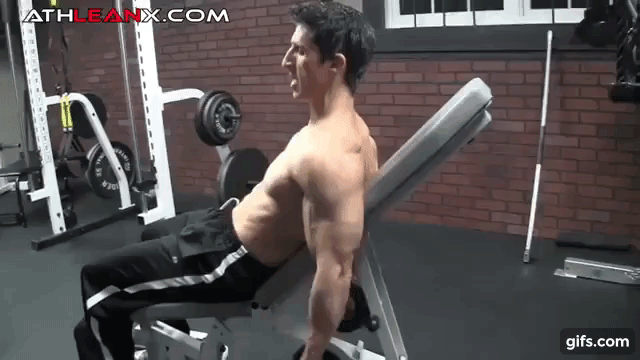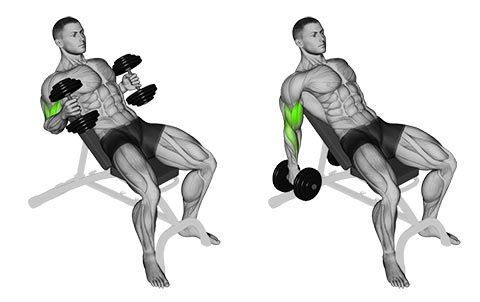The incline dumbbell curl is a highly effective exercise for targeting the biceps brachii, the muscles located on the front of the upper arm and the muscle that is maybe the most popular one among the fitness enthusiasts. By performing this exercise on an incline bench, you can isolate the biceps and achieve a greater range of motion, leading to increased muscle activation and growth. In this comprehensive guide, we’ll walk you through the proper technique, benefits, variations, and common mistakes of the incline dumbbell curl to help you achieve maximum results and avoid injury. Let’s get started.
Understanding the Incline Dumbbell Curl
The incline dumbbell curl is a variation of the traditional dumbbell curl, where you perform the exercise on an incline bench set at a 45-degree angle. This angle places the arms behind the body, stretching the biceps at the bottom of the movement and allowing for a greater range of motion during the curling motion.

Benefits of the Incline Dumbbell Curl
Increased Range of Motion
Performing the dumbbell curl on an incline bench allows for a greater stretch in the biceps at the bottom of the movement, leading to increased muscle activation and growth.
Isolation of the Biceps
The incline angle of the bench helps to isolate the biceps by minimizing involvement of other muscle groups, such as the shoulders and back, leading to more targeted muscle development.
Variation in Training
Incorporating the incline dumbbell curl into your routine provides variation in your biceps training, helping to prevent plateaus and stimulate muscle growth for bigger arms.

Improved Muscle Symmetry
Performing unilateral (one-arm) incline dumbbell curls can help address muscle imbalances between the left and right arms, leading to improved symmetry and aesthetics.
How to Perform the Incline Dumbbell Curl
- Adjust the incline bench to a 45-degree angle. Sit down on the bench with your back against the pad and hold a dumbbell in each hand, palms facing forward.
- Let your arms hang straight down by your sides, with your elbows fully extended and your palms facing forward. Your feet should be flat on the floor, shoulder-width apart, and your chest should be lifted.
- Keeping your upper arms stationary and your elbows close to your sides, exhale as you curl the dumbbells upwards towards your shoulders. Focus on squeezing your biceps at the top of the movement for the best muscle contraction.
- At the top of the movement, your palms should be facing your shoulders, and your biceps should be fully contracted. Hold this position for a brief moment like for 1-2 seconds to maximize muscle engagement.
- Inhale as you slowly lower the dumbbells back down to the starting position, maintaining control and resisting the urge to let the weights drop.
- Ensure that you fully extend your elbows at the bottom of the movement to stretch the biceps, and fully contract your biceps at the top of the movement to maximize muscle activation.
- Complete the desired number of repetitions with proper form and technique. Aim for 8-12 repetitions per set, adjusting the weight as needed to challenge your muscles while maintaining good form.
- Once you’ve completed your sets, carefully place the dumbbells back on the floor and take a moment to stretch your biceps and upper body to promote recovery and flexibility.

Incorporating the Incline Dumbbell Curl into Your Routine
The incline dumbbell curl can be incorporated into your biceps training routine to build strength, muscle mass, and definition in the biceps. Aim to include this biceps movement as part of your arm training or with back training in your pull day if you are following push pull legs protocol.
Perform the exercise 3-4 sets of 8-12 repetitions per session. Start with a light weight to warm up the muscles and gradually increase the weight as you become more comfortable with the movement.
In addition to the incline dumbbell curl, include a variety of other biceps exercises in your arm day or pull day such as barbell curls, preacher curls, and hammer curls to target different areas of the biceps and ensure balanced muscle development.
Common Mistakes to Avoid
Using Momentum
Don’t swing or use momentum to lift the dumbbells, as this reduces the effectiveness of the exercise and increases the risk of injury. Focus on using slow, controlled movements with moderate weights to maximize muscle engagement.
Incomplete Range of Motion
Ensure that you fully extend your elbows at the bottom of the movement to stretch the biceps, and fully contract your biceps at the top of the movement to maximize muscle activation. Avoid cutting the range of motion short, as this limits muscle growth and development.
Rounding the Shoulders
Keep your shoulders down and back throughout the exercise, avoiding hunching or rounding of the shoulders. This helps to maintain proper alignment and prevents strain on the shoulder joints.
Gripping the Dumbbells Too Tightly
Avoid gripping the dumbbells too tightly, as this can lead to tension in the forearms and wrists. Instead, maintain a firm but comfortable grip on the dumbbells throughout the exercise.
Using Excessive Weight
Choose a weight that allows you to perform the exercise with proper form and technique for at least 8 repetitions. Using excessively heavy weights can compromise your form and increase the risk of injury.
Also Read: Cable Bicep Curl: How To, Tips, Benefits, Variations & More!
Variations of the Incline Dumbbell Curl
Alternating Incline Dumbbell Curl
Perform the exercise with one arm at a time, alternating between the left and right arms. This variation helps to address muscle imbalances and increase stability and coordination.
Hammer Grip Incline Dumbbell Curl
Instead of curling the dumbbells with your palms facing upwards, keep your palms facing each other throughout the movement. This variation targets the brachialis muscle in addition to the biceps.

Supinated Grip Incline Dumbbell Curl
Perform the incline dumbbell curl with a supinated grip (palms facing upwards) to emphasize the short head of the biceps. This variation provides a greater stretch in the biceps and targets the muscle from a different angle.
Conclusion
The incline dumbbell curl is an amazing exercise for targeting the biceps and achieving greater muscle activation, size and growth. By mastering proper technique, avoiding common mistakes, and incorporating variations into your routine, you can maximize the benefits of this exercise and achieve your fitness goals safely and effectively. Whether you’re a beginner or an experienced lifter, the incline dumbbell curl offers a valuable addition to your biceps training arsenal for sculpting strong, defined arms and improving overall arms’ strength, size & aesthetics. Hopefully, you found this article helpful enough. If you really did then let us know your unfiltered thoughts in the comment section without any hesitation. Thanks for visiting and appreciating our work.
